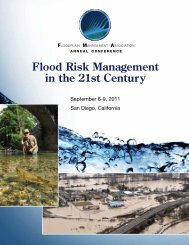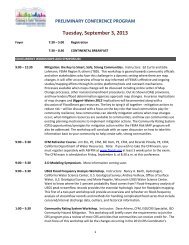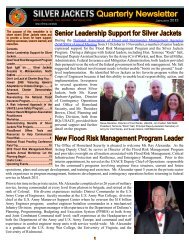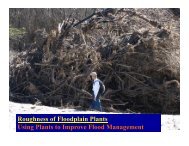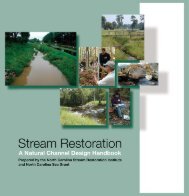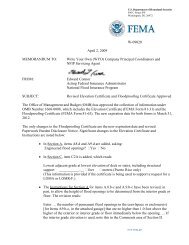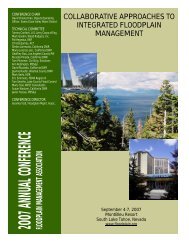Using Multi-Objective Management to Reduce Flood Losses in Your
Using Multi-Objective Management to Reduce Flood Losses in Your
Using Multi-Objective Management to Reduce Flood Losses in Your
Create successful ePaper yourself
Turn your PDF publications into a flip-book with our unique Google optimized e-Paper software.
Plann<strong>in</strong>g and zon<strong>in</strong>g<br />
Comprehensive plans and land use plans specify how a community should be<br />
developed (and where development should not occur). Through these plans, uses<br />
of the land can be tailored <strong>to</strong> match the land’s hazards. For example, flood hazard<br />
areas can be reserved for parks, golf courses, backyards, wildlife refuges, natural<br />
areas, or similar uses that are compatible with the natural flood<strong>in</strong>g process.<br />
Plans like these usually have limited authority. They reflect what the<br />
community would like <strong>to</strong> see happen. But they can be powerful because they<br />
shape the character of other local measures, such as capital improvement<br />
programs, zon<strong>in</strong>g ord<strong>in</strong>ances, and subdivision rules.<br />
A community’s capital improvement program identifies where major public<br />
expenditures will be made over the next 5 <strong>to</strong> 20 years. Capital expenditures may<br />
<strong>in</strong>clude acquir<strong>in</strong>g land for public uses, such as parkland, wetlands, or natural<br />
areas, and extension or improvement of roads and utilities. These publicly funded<br />
projects should not aggravate flood<strong>in</strong>g. In fact, they can reduce<br />
For more<br />
<strong>in</strong>formation on the<br />
agencies and<br />
organizations,<br />
check the<br />
M.O.M. Resource<br />
Direc<strong>to</strong>ry or see<br />
Appendix A. See<br />
Appendix B for<br />
more <strong>in</strong>formation<br />
on the references<br />
listed.<br />
flood<strong>in</strong>g by, for example, enlarg<strong>in</strong>g a culvert open<strong>in</strong>g while a<br />
road is be<strong>in</strong>g repaired.<br />
A zon<strong>in</strong>g ord<strong>in</strong>ance regulates development by divid<strong>in</strong>g the<br />
community <strong>in</strong><strong>to</strong> zones or districts and sett<strong>in</strong>g development criteria<br />
for each district. The floodpla<strong>in</strong> can be designated as one or more<br />
separate zon<strong>in</strong>g districts <strong>in</strong> which development is prohibited or<br />
allowed only if it is not susceptible <strong>to</strong> flood damage. Some<br />
districts that are appropriate for floodpla<strong>in</strong>s are those designated<br />
for public use, conservation, agriculture, and cluster or planned<br />
unit developments that keep build<strong>in</strong>gs out of the floodpla<strong>in</strong>,<br />
wetlands, and other risky or sensitive areas.<br />
To F<strong>in</strong>d Out More > > Technical advice about plann<strong>in</strong>g<br />
and zon<strong>in</strong>g can also be found at your local, regional, or state<br />
plann<strong>in</strong>g agencies. The American Plann<strong>in</strong>g Association and its<br />
state chapters can provide technical assistance <strong>to</strong> its members.<br />
Open space preservation<br />
Keep<strong>in</strong>g the floodpla<strong>in</strong> free from development is the surest way <strong>to</strong> prevent flood<br />
damage. Open space preservation should not be limited <strong>to</strong> floodpla<strong>in</strong>s, because<br />
some sites <strong>in</strong> the watershed (but outside the floodpla<strong>in</strong>) may be crucial <strong>to</strong><br />
controll<strong>in</strong>g runoff that adds <strong>to</strong> the flood problem. Areas that need <strong>to</strong> be preserved<br />
<strong>in</strong> a natural state should be listed <strong>in</strong> land use and capital improvement plans.<br />
Exist<strong>in</strong>g undeveloped areas can be preserved as open space through zon<strong>in</strong>g<br />
ord<strong>in</strong>ances. Lands that ought <strong>to</strong> be set aside as open space but are already be<strong>in</strong>g<br />
put <strong>to</strong> other uses can be converted <strong>to</strong> public ownership (acquisition) or <strong>to</strong> public<br />
use (easement). Once the land is owned by the county, municipality, or state,<br />
build<strong>in</strong>gs and other development subject <strong>to</strong> flood damage can be removed or<br />
prohibited. With an easement, a private owner is free <strong>to</strong> develop and use the<br />
property, but agrees <strong>to</strong> not build on the flood-prone part or the part set aside <strong>in</strong><br />
the easement. In exchange, property taxes are reduced or a payment is made.<br />
Open space lands and easements do not always have <strong>to</strong> be purchased<br />
outright. Developers can be required <strong>to</strong> dedicate land <strong>to</strong> the public for a park<br />
and/or <strong>to</strong> provide easements for flood flow, dra<strong>in</strong>age, or ma<strong>in</strong>tenance. These are<br />
usually l<strong>in</strong>ear parcels along property l<strong>in</strong>es or channels. Ma<strong>in</strong>tenance easements<br />
14





